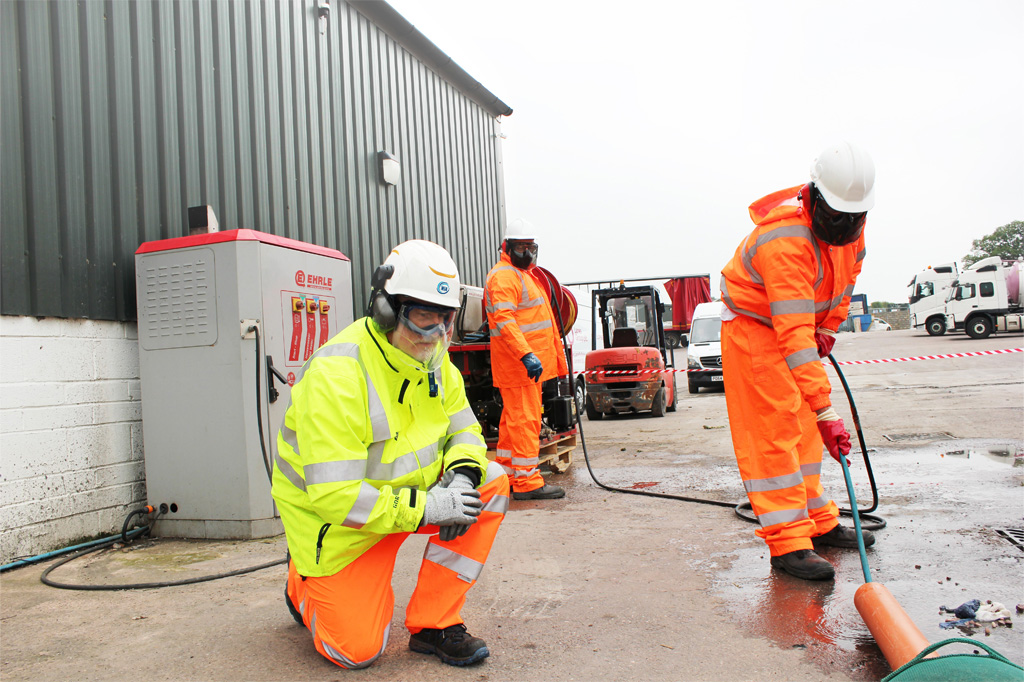Social Distance Learning – Water Jetting Training During Covid-19

Drainage operatives are a close-knit bunch but when it comes to water jetting training right now, a little bit of distance learning is applicable, even in the classroom.
Water Jetting Association (WJA) training providers and instructors are working with drainage and utility contractors to deliver vital training as the COVID-19 pandemic continues.
That has involved putting in place robust measures, including social distancing and the wearing of face masks in the training room, to maximise personal safety.
Darren Hamilton is a WJA-approved training instructor and a member of the association’s training and safety committee. He has been “flat out” running water jetting courses since the WJA approved the resumption of training on 4th July.
He said: “We’re catching up with our water jetting training programme that has been suspended for 19 weeks, and training does take longer under COVID-19 restrictions. But we’re managing.”
The signage on the training room door tells you the WJA COVID-19 rules and guidelines are in place. A company sign states only six people are allowed in at any one time, and the big yellow notice stating “Room COVID-19 Cleared” indicates that the a WJA risk assessment of the space has been carried out, and training can take place.
Inside, Darren Hamilton is leading operatives through the class-based element of the WJA’s drain and sewer practical module. Spread out, with empty chairs and desk space between them, their eyes stare intently at a screen, just above the mandatory face masks covering their noses and mouths.
The WJA has stipulated that any forms that need to be filled out and returned by operatives, including test papers, need to be laminated sheets, completed with wipeable pens. These can then be disinfected after use.
Darren Hamilton has chosen, instead, to take operatives through the test questions on screen, reading out the questions, as well as showing them.
“For me, this is the best way to reduce the risk of COVID-19 transmission,” he said. “I read out the question as well, because when shown on the screen, some delegates can have difficulty reading them.
“We always have to be mindful of people having different learning capabilities, but the COVID-19 pandemic has concentrates minds even more. Two-way communication during the training is vital to ensure everyone gets the most out of the experience, does well in the test, and leaves the training room best able to carry out their duties safely and effectively.
“This, and the smaller groups, are reasons why training is taking longer. But in some respects, COVID-19 may have the effect of improving training outcomes because the safety measures focus minds and require us all to concentrate harder on the job of teaching and learning.
“So far delegates have coped very well. They understand the need for procedures and standards. They come together from different sites so realise they need to socially distance to minimise the risk of COVID-19 transmission. Some question the need for restrictions but I point out they’re there for my safety as much as theirs.”
During practical training, which is completed outdoors, social distancing continues, with delegates remaining at least one metre apart, though only jetting masks must be worn as operatives are put through their paces.
The WJA has issued its training providers and instructors with a full suite of documentation to support the training process. Along with the risk assessment form, it includes a pre-start checklist to ensure all possible measures are in place to minimise COVID-19 risks.
There is a ‘face-to-face’ procedures document, joining instructions, screening questions, to identify at risk individuals, a COVID-19 vulnerability tool, and a special post-course evaluation form.
The response to the resumption of water jetting training has been positive, said John Jones, Chairman of the WJA Training and Safety Committee.
He added: “Measures we’ve introduced have been robust and have dovetailed well with those implemented by client organisations. We’re continuously monitoring progress and will amend our procedures and guidance as and when required.”
